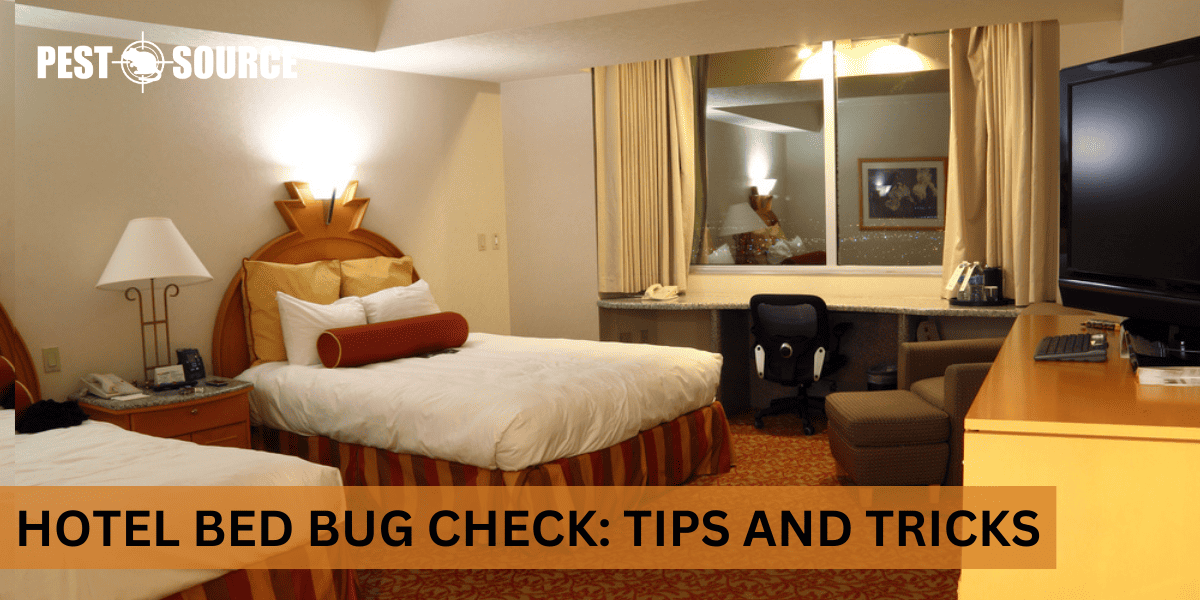To check for bed bugs in a hotel, inspect the bed by pulling back the linens to look for small, reddish-brown bugs, tiny white eggs, or dark spots on the mattress and headboard. Examine the surrounding furniture and any soft furnishings like chairs and curtains. This article will outline a comprehensive step-by-step process for thoroughly inspecting a hotel room to ensure a bed bug-free stay.
POINTS
- Bed bugs are small, flat, reddish-brown insects that can live in hotels by moving from one location to another through personal items like luggage. They are often found hiding in the seams of mattresses, upholstered furniture, and even in the folds of curtains or behind electrical outlets.
- Before booking a hotel, it is helpful to conduct a quick online research on the establishment. Look for mentions of bed bugs in online reviews on platforms like TripAdvisor or The Bed Bug Registry. Always opt for a hotel that maintains high standards of cleanliness and has a reputation for timely and effective response to bed bug reports.
- Upon arrival in a hotel, inspect the room thoroughly before unpacking. Use a flashlight to check for signs of bed bugs such as molted skins, fecal spots, and egg cases on the mattress seams, behind the headboard, along the box spring, as well as on nearby furniture.
- Pack a bed bug detector for your protection. These devices use heat and CO2 to attract and capture bed bugs, making it easier to detect their presence in a room. Other tools like UV flashlights or double-sided tape can also be used to spot these pests.
- If you find bed bugs in your hotel room, immediately report to the hotel management. Ask to be moved to another room that’s not adjacent or directly below or above the infested room. If the hotel fails to provide a safe alternative, consider changing your accommodation and leave an accurate review online to alert other potential guests.
The Importance of Checking for Bed Bugs During Hotel Stay
Why is it important to check for bed bugs in hotels?
It is important to check for bed bugs in hotels to protect yourself from bites, allergic reactions, and to avoid accidentally bringing these pests into your home. Bed bugs are tiny creatures that feed on human blood, usually leaving behind itchy, red bites. They’re notorious hitchhikers which means they can easily move from the hotel to your home via your luggage.
What are bed bugs, and why are they a concern in hotels?
Bed bugs are small, oval, brownish pests that live on the blood of animals or humans. Their size enables them to hide in small spaces, such as the seams of a mattress, making hotels a prime breeding ground due to the high turnover of guests. Bed bugs are a concern because of their bites can cause allergic reactions, sleep disturbances, and severe itchiness. They can also be challenging and expensive to eliminate once they’ve entered your home.
Understanding Bed Bugs
What are the characteristics of bed bugs?
Bed bugs are small, flat insects that have a reddish-brown color. They are about the size of an apple seed and can easily hide in narrow cracks and crevices due to their flat bodies. They are nocturnal, making them hard to spot during the day. Bed bugs don’t have wings, so they cannot fly or hop, but they can crawl quickly over floors, walls, and ceilings.
How can bed bugs infest hotels?
Bed bugs infest hotels by moving from one location to another through personal items like luggage, purses, and backpacks. If a guest with bed bugs stays in a hotel room, the bed bugs can crawl out of the guest’s belongings and infest the room. From there, the bed bugs can spread to other rooms through wall voids, electrical outlets, and laundry carts.
Where are bed bugs commonly found in a hotel room?
Bed bugs are commonly found in and around the bed because they are closest to their food source – you. Check the mattress seams, bed frames, headboards, and box springs. But don’t limit your search to the bed. These pests can also be found in furniture such as nightstands, desks, and upholstered chairs, as they can easily hide in the small crevices of these items. Even curtains, behind wallpaper, under the carpet, and power outlets are not beyond their reach.
How can bed bugs affect your stay in a hotel?
Having bed bugs in your hotel room can turn your relaxing stay into a nightmare. The bites can cause discomfort, distract you from your planned activities, and create stress and anxiety. Even more concerning is the possibility of bringing these pests back home, which can lead to a larger infestation and high extermination costs.
Preparatory Actions: How to Minimize the Risk of Encountering Bed Bugs
How to research and find information on hotels with bed bug infestations?
Online resources can be a game-changer when it comes to researching bed bug infestations in hotels. Websites such as The Bed Bug Registry and online review sites like TripAdvisor are dedicated to letting guests report bed bug encounters. Simply input the hotel’s name to see if there have been any bed bug complaints. Keep in mind that one report shouldn’t disrupt your decision, focus on patterns instead.
What are the red flags to look for in online hotel reviews concerning bed bugs?
Scan for mentions of bites, itching, or insects. Specifically, reviews that mention waking up with a series of red bumps, particularly in a straight line or zigzag pattern, may indicate bed bug infestations. Additionally, reviews discussing a hotel’s lack of refraining action or insufficient remediation after a guest reported a problem should raise concerns.
How to choose a hotel with minimal risk of bed bug infestation?
Hotels with a good reputation for cleanliness and customer service are less likely to have long-term bed bug infestations. They respond to problems promptly, and the chances are high that they have regular pest control inspections.
Checking the Room: How to Inspect a Hotel Room for Bed Bugs
How to check the bed for bed bugs in a hotel room?
Begin by pulling back the bed linens and inspecting the mattress, focus on the corners and seams. Look for tiny black spots (fecal matter), tiny white spots (eggs), or actual bed bugs.
How to inspect your room before unpacking?
Before you unpack, it’s a good idea to inspect not only the bed but also nearby furniture and luggage racks. Bed bugs can hide in upholstery and wooden furniture, so don’t forget to check in, under, and behind sofas, chairs, dressers, and bedside tables.
How to use a flashlight effectively when looking for bed bugs?
Having a small, intense beam flashlight can greatly aid your inspection. Use it to inspect the dark recesses of your room – under furniture, between cushions, behind headboards, and even around the edge of the carpet. Remember, bed bugs are evasive, they like to hide in the dark and come out when you’re asleep, so don’t neglect the dimly lit areas.
The Bed: How to Check a Hotel Bed for Bed Bugs
Where in the bed should you check for bed bugs (mattress seams, box spring, headboard)?
Bed bugs like to stay close to their meal source, which means the bed is a prime location. Start with the headboard, often ignored, it can be a prime spot for bed bugs. Proceed to the mattress, pay special attention to the seams and any visible piping. Also, inspect the box spring, particularly the corners and the underside, as these are favorite hiding spots for bed bugs.
What signs on the bedding (sheets, blankets, pillowcases) might indicate a bed bug presence?
Blood smears or rust-colored stains may indicate crushed bed bugs. Tiny black spots may be bed bug excrement, and small white spots could be their eggs.
What are the specific signs to look for in the bedding and mattress?
Look for molted bed bug skins, fecal spots, and egg cases on the mattress seams, behind the headboard, along the box spring, and even on the bedding. These are surefire signs of a bed bug infestation.
The Furniture: How to Inspect Hotel Furniture for Bed Bugs
How to check upholstered furniture (chairs, couches, ottomans) for bed bugs?
Inspect all upholstered furniture carefully, not just the bed. Use your flashlight to check for the same signs we looked for on the bed: black spots, white spots, or actual bugs. Pay attention to seams, tufts, skirts, and crevices underneath. Don’t forget to look at the back and underneath, too.
How to check less obvious places of a hotel room for bed bugs (folds of the curtains, backs of the electrical outlets)?
Bed bugs can hide in less obvious places such as the folds of curtains, behind picture frames, loose wallpapers, under carpets, and in the corners of dressers and drawers. Even electrical outlets are not safe from these crafty pests. Pop off the plate of a few outlets and shine a flashlight behind it to see if bed bugs are hiding there.
Your Belongings: How to Check Your Luggage for Bed Bugs
How to check your luggage before leaving the hotel room to avoid bringing bed bugs home?
Before packing, it’s crucial to check your luggage for stowaway bed bugs. They might be hiding in the seams or pockets of your suitcase. Be sure to inspect every compartment, paying special attention to the zippers and seams. Shake out all your clothes and other items before repacking them.
Where to check in your luggage for signs of bed bugs (seams, pockets, compartments)?
Scan all around the seams, any exterior pockets, and the compartments of your luggage. The bed bugs can be hiding or laying eggs in these areas. Look for tiny white eggs, brownish skins, and the bugs themselves.
Detection Tools: How to Use a Bed Bug Detector in a Hotel
What is a bed bug detector and how can it be used in a hotel room?
A bed bug detector is a device used to trap and identify bed bugs in your environment. There are a few types on the market, from small, plastic dishes that go under the legs of your bed to intercept bugs, to advanced devices that use heat and CO2 to lure bugs into a trap. When inspecting a room, place detectors under the bed or near sleeping areas for optimal results. After a few hours or overnight, check traps for signs of any trapped bugs.
Are there other tools or techniques for detecting bed bugs in hotels?
Yes, along with bed bug detectors, there are other tools and techniques like UV flashlights, which can highlight the phosphorous contained in bed bug exoskeletons, making them easier to spot. Some people also use double-sided tape around the edges of the mattress or on the floor to catch bed bugs.
Action Steps: What to Do if You Find Bed Bugs in Your Hotel Room
What to do if you find bed bugs in your hotel room?
If you discover bed bugs in your room, immediately notify hotel management. Put the bug in a sealed bag and show it to them as proof. Request a new room that’s not adjacent or directly below or above the infested room, as bed bugs can easily move between rooms.
How to report bed bugs to hotel management?
Once you’ve taken photos or collected a sample of the bed bugs, take them to the front desk. Politely, but firmly report the issue, and ask for an alternative room. If they’re unwilling or unable to provide a safe alternative, consider finding a different hotel. Remember to leave a comprehensive review online to warn future travelers.
How to Check for Bed Bugs in Your House?
To check for bed bugs in your house, start by examining your bed. Strip the bedding and check the mattress seams, box spring, bed frame, and headboard for small brown insects, tiny white eggs, or dark spots from excrement. Look beyond the bed, inspecting furniture, baseboards, and even electrical outlets. Use a flashlight for better visibility and consider a magnifying glass for small crevices. If signs are found, contact a pest control professional for confirmation and treatment.



